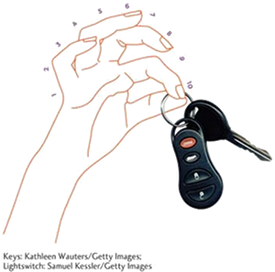summary of concepts


LO 1 Define psychological disorders and the criteria used to identify abnormal behavior. (p. 476)
A psychological disorder is a set of behavioral, emotional, or cognitive symptoms that are significantly distressing in terms of social functioning, work endeavors, and other aspects of life. Abnormal behavior often falls along a continuum and is based on typicality and the 3 Ds: dysfunction, distress, and deviance. This continuum includes what we would consider normal at one end and abnormal at the other end, and is determined in part by one’s culture.
LO 2 Recognize limitations in the classification of psychological disorders. (p. 482)
Although a classification system is important for communication and treatment planning among professionals, it can lead to labeling and create expectations. Because of the stigma associated with psychological disorders, the effects of a diagnosis can be long lasting. Some critics suggest there is too much emphasis on the medical model, which may ignore the importance of psychological and sociocultural factors.
LO 3 Summarize the etiology of psychological disorders. (p. 484)
The biopsychosocial perspective provides a model for explaining the causes of psychological disorders, which are complicated and often result from interactions among biological, psychological, and sociocultural factors.
Important biological factors include neurochemical imbalances and genetic predispositions for disorders. Psychological influences include cognitive factors and developmental experiences. Sociocultural factors, such as poverty and support systems, may also impact the development and course of psychological disorders.
LO 4 Define anxiety disorders and demonstrate an understanding of their causes. (p. 486)
Anxiety disorders are a group of psychological disorders associated with extreme anxiety and/or irrational fears that are debilitating. Panic disorder includes worries about experiencing unexpected panic attacks or losing control. Specific phobias are characterized by a distinct fear or anxiety in relation to an object or situation. Agoraphobia is a distinct fear or anxiety related to situations such as public transportation, open spaces, retail stores, crowds, or being alone and away from home. Social anxiety disorder is a type of phobia in which a person has a distinct fear or anxiety regarding social situations, particularly the idea of being scrutinized by others. Someone with generalized anxiety disorder experiences an excessive amount of worry and anxiety about many activities relating to family, health, school, and other aspects of daily life. Anxiety disorders can develop as a result of environmental factors and genetic predisposition, and are more prevalent in women. They can be culture specific and/or learned.
511
LO 5 Summarize the symptoms and causes of obsessive-
Obsessive-
LO 6 Summarize the symptoms and causes of major depressive disorder. (p. 492)
Symptoms of major depressive disorder include feelings of sadness or hopelessness, reduced pleasure, sleeping excessively or not at all, loss of energy, feelings of worthlessness, or difficulties thinking or concentrating. With major depressive disorder, there is substantial severity of symptoms and impairment in the ability to perform expected roles. Biological theories suggest the disorder results from a genetic predisposition, and irregular activity of neurotransmitters and hormones. Psychological theories suggest that feelings of learned helplessness and negative thinking may play a role. Major depressive disorder results from a combination of several factors.
LO 7 Compare and contrast bipolar disorders and major depressive disorder. (p. 497)
A diagnosis of bipolar I disorder requires that a person experience at least one manic episode, substantial distress, and great impairment. Bipolar II disorder involves at least one major depressive episode as well as a hypomanic episode, which is associated with some of the same symptoms as a manic episode, but is not as severe and does not impair one’s ability to function. People with bipolar disorder cycle between extreme highs and lows of emotion and energy that last for days, weeks, or even months. Individuals with major depressive disorder, on the other hand, tend to experience a persistent low mood, loss of energy, and feelings of worthlessness.
LO 8 Recognize the symptoms of schizophrenia. (p. 499)
Schizophrenia is a disabling disorder that can involve delusions, hallucinations, disorganized speech, abnormal psychomotor behavior, diminished speech, limited emotions, or loss of energy. Delusions are strange and false beliefs that a person maintains even when presented with contradictory evidence. Hallucinations are “perception-
LO 9 Analyze the biopsychosocial factors that contribute to schizophrenia. (p. 501)
Schizophrenia is a complex psychological disorder that results from biological, psychological, and social factors. Because this disorder springs from an interaction of genes and environment, researchers have a hard time predicting who will be affected. The diathesis–
LO 10 Differentiate between antisocial and borderline personality disorders. (p. 504)
People with antisocial personality disorder may seek personal gratification even when it means violating ethics and breaking laws. They sometimes deceive people, and exhibit aggressive, impulsive, or irritable behavior. These individuals lack empathy, and may not show concern for others or feel remorse upon hurting someone. Borderline personality disorder is distinguished by an incomplete sense of self and feelings of emptiness. Those affected may exhibit intense anger, have difficulty controlling their temper, and get into physical fights. They can be impulsive, especially where sexual activity, substance abuse, and spending money are concerned. Suicide threats and attempts may occur repeatedly. Both disorders may result in issues with intimacy and trust.
LO 11 Identify differences among dissociative disorders. (p. 506)
People suffering from dissociative amnesia seem unable to remember important information about their lives. If a person with dissociative amnesia also wanders in a confused and unexpected manner, this is considered dissociative amnesia with dissociative fugue. Dissociative identity disorder occurs when an individual experiences two or more distinct personalities. This disorder is considered the most complicated and persistent of the dissociative disorders. The commonality in this group of disorders is dissociation, or a disturbance in the normally unified experience of psychological functions involved in memory, consciousness, perception, or identity.